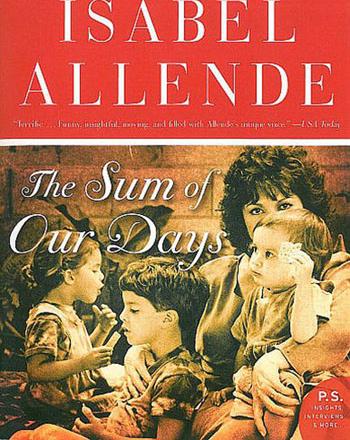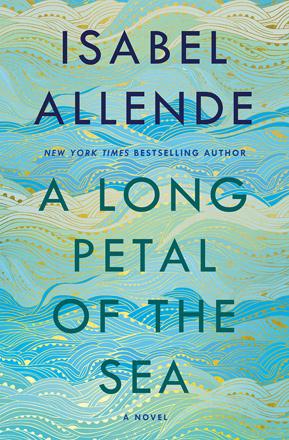You are here
Literature and the tribe
By Sally Bland - Nov 16,2014 - Last updated at Nov 16,2014

The Sum of Our Days
Isabel Allende
Translated by Margaret Sayers Peden
London: HarperCollins, 2009
Pp. 301
This is the sequel to “Paula”, the memoir Isabel Allende wrote in response to the tragic death of her daughter in 1992. “The Sum of Our Days” is also addressed to Paula, intending to keep her abreast of happenings in the lives of her loved ones, for in Allende’s world, the demarcation between the living and the dead is ever-shifting and porous. As she writes, Allende is still grieving, but life goes on; the family is expanding and there are new tragedies and joys to relate. Like all of Allende’s writing, fictional or otherwise, this book celebrates life, love, family, imagination, dreams and spirituality.
After Paula’s death, Allende fears that her muse had dried up and she will not be able to write fiction again. Falling back on her earlier experience as a journalist, she assigns herself a topic to research, travels to India and the Amazon, and publishes “Aphrodite”, a collection of recipes, sensuous stories and aphrodisiacs. She also establishes a foundation to aid poor women in different parts of the world — an idea suggested to her by Paula.
Gradually and with a concerted effort, the muse returns and one learns the inside story of Allende’s ensuing novels: “Daughter of Fortune”, “Portrait in Sepia” and “The City of the Beasts” — the first in a trilogy of children’s adventures which grew out of telling her grandchildren stories. In connection with telling about writing “Ines of My Soul”, she identifies the pattern in her fiction: “In nearly all my books there are defiant women, born poor or vulnerable, destined to be subjected, but they rebel, ready to pay the price of freedom at any cost. Ines Suarez is one of them. My female protagonists are always passionate in their loves and loyal to other women. They are not moved by ambition but by love.” (p. 267)
Judging from what the author reveals about herself in this book, it means they are all somehow similar in character, if not in background, to her.
More than a literary memoir, this is a chronicle of family, though perhaps one shouldn’t separate the two as Allende often confides that she draws her characters and inspiration from real people, usually relatives. The loss of her daughter seems to have doubled her commitment to insuring the welfare of the remaining family. Allende’s love, caring and involvement — sometimes too much, she admits — in the life of her son and grandchildren, is at the core of the book. Gathering her extended family around the home she and her second husband, the lawyer Willie Gordon, build in Northern California is her top priority. The family is so expansive and branched that she calls it a tribe. Marrying a family member is enough to gain admittance; even in the case of divorce, membership is retained for those who continue to share their love. Blood relations is not a requirement; the tribe includes soul mates who contribute to its warmth and togetherness and share in its formative experiences.
Though in many ways embracing her new life in the United States whole-heartedly, Allende continues to write in Spanish and to preserve the family traditions which she brought with her from her native Chile. “A tribe has its inconveniences, but also many advantages. I prefer it a thousand times to the American dream of absolute individual freedom, which, though it may help in getting ahead in this world, brings with it alienation and loneliness.” (p. 173)
Also, in other ways, her commentary on the American way of life and its politics are priceless.
The first part of the book focuses on the efforts of Isabel and Willie to save his drug-addicted daughter from a previous marriage, and when that fails, to find a nurturing home for the premature child she gave birth to, who is not expected to live. But live Sabrina does, thanks to intense care and love from the tribe. Sabrina’s story is emblematic as the tribe’s fortunes swing from heart-rending situations worthy of Greek tragedy, to near miracles. There is also a fair share of tension in Isabel’s marriage and within the tribe, which she sometimes describes with tongue in cheek: “Fortunately… the family melodramas continued, because if not, what the devil would I write about?” (p. 57)
The years covered in the book (1993-2006) span the birth and coming of age of Allende’s grandchildren, the maturation of her marriage and deepening of the love between her and her husband. “The Sum of Our Days” is also about getting older gracefully. Allende is humbled by life but never daunted. Her prose, as always, is lush, passionate and evocative.
Related Articles
In the Midst of WinterIsabel AllendeTranslated from the Spanish by Nick Caistor and Amanda HopkinsLondon: Scribner, 2018Pp.
A Long Petal of the SeaIsabel AllendeTranslated from the Spanish by Nick Caistor and Amanda HopkinsonNew York: Ballantine Books, 2020Pp.
The Japanese LoverIsabel AllendeTranslated by Nick Caistor and Amanda HopkinsonNew York: Atria Books, 2015Pp.


















